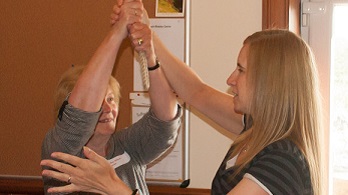M1: 14 Sep 2013 - Tulloch
Nearly two years after Pip Penny heroically travelled to St Andrews to deliver Day Courses in both Modules of the ITTS Scheme in a single intensive weekend, the Scottish Association began its training campaign in earnest, using lessons learned from that first Day Course to improve the learning experience and increase the long-term effectiveness of the training.
The first key to doing this was to build sufficient expertise locally to be able to run our own ITTS Day Courses, eliminating significant organisational overheads, and allowing us to run smaller courses more frequently. The first of these was a Module 1 Day Course held mid-September at the Tulloch Ringing Centre, run by Judith Frye (and assisted by Jonathan Frye, the SACR Ringing Master).
There were nine ‘new’ Teachers-in-training attending the Day Course, coming from Inverness, Glasgow, Dumfries and Alderney (a little know very southern branch of the SACR). One of our number had been ringing a little over a year and was using the Day Course to gain experience before returning to help train a novice band. The two ringers from Dumfries had had long breaks from ringing, but were also preparing for the time when their bells were in place. The remaining Delegates had a scary number of years accumulated of ringing and teaching ringing, and were, for the most part, already active in teaching handling.
This left Judith delivering her first ITTS Day Course to a highly critical, but also highly engaged audience, and the formal presentation included a certain amount of free discussion, as the ITTS principles and ideas were considered alongside previous assumptions and experience, tested, attempted in practical sessions, and reconsidered. Our own group from Glasgow were particularly interested in how well the training ideas would translate to our pretty challenging and non-ideal teaching environment.
The practical sessions were extremely enabling, and while probably everyone started off feeling odd ‘teaching’ handling to someone who already knew how to ring, it worked extremely well, and the ringers sparked off each other with feedback and ideas.
For those ringers who were able to stay an extra day, our host and fellow student Helen McGregor laid on some willing guinea pigs who were completely new to ringing, and we had a couple of hours trying out these new ideas while they were still very fresh. This was a very powerful enforcement tool for what we had learned the day before, and we’d recommend this follow-up to anyone else taking a Day Course. Each of us found different handling exercises useful or comfortable, and the pick-and-mix approach allowed all of us to create our own little course that suited our own and our ‘guinea pigs’s style. Comparing notes again after this was also extremely useful.
At the close of the Day Course, and at Judith’s suggestion, we agreed a ‘reunion’ or follow-up meeting in order to help mitigate against the considerable geographic dispersal of our group, and to be able to support each other and discuss forward and backward progress. This is also a very good ‘extra’ element that should prove useful.
However, many benefits did not reveal themselves until after the Day Course had completed. For instance, at our very next tower practice, I could see fellow ITTS Delegates tackling persistent handling issues in the band by using some of the teaching tips, and applying some techniques to our existing learners. The concept of ‘breaking things down’ into simpler elements is very powerful, and we have been applying it to many other ringing situations than pure handling. In sharing our experience of the Scheme, and what we found useful and not so useful, we started a discussion amongst the local band about the different ways we approach learning new things in ringing, and this in turn will (with luck and application) make the whole practice night more responsive.
Our children’s primary school uses the ‘three stars and a wish’ system for encouraging learning, and along those lines I offer the following:
We liked:
- The opportunity to work together as a group significantly enhanced the learning experience, and is one of the more powerful aspects of the Day Course. While it is possible to ‘read all about it’ all by oneself, the interactive aspect is really crucial, and especially so for geographically dispersed areas.
- The ‘safe’ environment of trying out new techniques on experienced ringers worked really well.
- The idea of having a ‘toolbox’ of techniques and exercises, so that there was always something else to try if something wasn’t working, is quite powerful.
We wish:
- The powerpoint presentation for the theory sessions contained more useful information. The real nuggets were in the accompanying notes, while the public-facing part of the presentation was a bit insipid. We would have benefitted just as much with a simple lecture and dispensed with the technology, which is a missed opportunity.
Tina Stoecklin

Course Tutor: Judith Frye
Teaching Bell Handling
Practical advice for teachers, right from the first lesson.